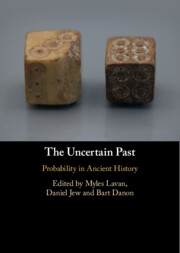Book contents
- The Uncertain Past
- The Uncertain Past
- Copyright page
- Contents
- Figures
- Tables
- Contributors
- Acknowledgements
- 1 Probabilistic Modelling in Ancient History
- Part I Uncertainty
- Part II Variability and Missing Data
- 5 Children and Their Impact on Family Finances in Roman Egypt
- 6 The Financial Sustainability of Grain Funds
- 7 New Approaches to the Urban Population and Urbanization Rate of the Roman Empire, AD 1 to 200
- 8 Afterword
- Index
- References
7 - New Approaches to the Urban Population and Urbanization Rate of the Roman Empire, AD 1 to 200
from Part II - Variability and Missing Data
Published online by Cambridge University Press: 18 November 2022
- The Uncertain Past
- The Uncertain Past
- Copyright page
- Contents
- Figures
- Tables
- Contributors
- Acknowledgements
- 1 Probabilistic Modelling in Ancient History
- Part I Uncertainty
- Part II Variability and Missing Data
- 5 Children and Their Impact on Family Finances in Roman Egypt
- 6 The Financial Sustainability of Grain Funds
- 7 New Approaches to the Urban Population and Urbanization Rate of the Roman Empire, AD 1 to 200
- 8 Afterword
- Index
- References
Summary
Although we have made great strides in the last few years in our understanding of the size of the urban population of the Roman Empire, there is still some uncertainty about how to extrapolate from the sample of sites for which we have evidence to the total number of sites that we know existed, with obvious implications for our view of the urbanization rate. In this chapter, I investigate whether we can use probabilistic approaches not only to shed new light on the size of the urban population and urbanization rate (and how they changed over time), but also to assess our degree of confidence about them. This exercise suggests that, although the size of the urban population was reasonably large by historical standards, it grew extremely slowly in comparative terms, with a minimum doubling time of just over 600 years. This indicates a constant urbanization rate, with about a fifth of the inhabitants of the Roman Empire living in cities for most of the Imperial period.
Keywords
- Type
- Chapter
- Information
- The Uncertain PastProbability in Ancient History, pp. 271 - 296Publisher: Cambridge University PressPrint publication year: 2022



